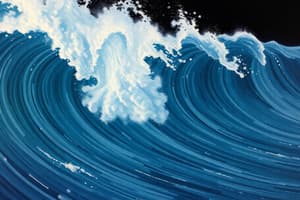Podcast
Questions and Answers
What is the term for the point in a standing wave that exhibits the greatest amplitude?
What is the term for the point in a standing wave that exhibits the greatest amplitude?
- Node
- Wavelength
- Frequency
- Antinode (correct)
What phenomenon causes the periodic rise and fall in volume when two guitar strings are tuned to slightly different frequencies and plucked simultaneously?
What phenomenon causes the periodic rise and fall in volume when two guitar strings are tuned to slightly different frequencies and plucked simultaneously?
- Harmonics
- Beats (correct)
- Timbre
- Resonance
What range of sound wave frequencies can most humans typically perceive?
What range of sound wave frequencies can most humans typically perceive?
- 10 Hz to 100,000 Hz
- 20 Hz to 20,000 Hz (correct)
- 30 Hz to 30,000 Hz
- 1 Hz to 10,000 Hz
In what units is the intensity level of sound waves measured?
In what units is the intensity level of sound waves measured?
What term describes the aspect of sound that depends on the specific harmonics that are present?
What term describes the aspect of sound that depends on the specific harmonics that are present?
What is the effect of sound waves at approximately 120 dB on the typical human ear?
What is the effect of sound waves at approximately 120 dB on the typical human ear?
What is the relationship between a fundamental wave and a harmonic wave in the context of sound?
What is the relationship between a fundamental wave and a harmonic wave in the context of sound?
Sound waves are best described as...
Sound waves are best described as...
What determines the maximum amplitude in a compression wave?
What determines the maximum amplitude in a compression wave?
Why can't sound waves travel through a vacuum?
Why can't sound waves travel through a vacuum?
Which of the following is a key difference between light waves and sound waves?
Which of the following is a key difference between light waves and sound waves?
What is the relationship between frequency (f) and period (T) of a wave?
What is the relationship between frequency (f) and period (T) of a wave?
What happens to a wave when it undergoes refraction?
What happens to a wave when it undergoes refraction?
What causes diffraction?
What causes diffraction?
When two identical sine waves are overlaid, exactly half a phase out of synchronisation, what is the result?
When two identical sine waves are overlaid, exactly half a phase out of synchronisation, what is the result?
Under what condition are standing waves typically formed?
Under what condition are standing waves typically formed?
Flashcards
Wave Motion
Wave Motion
Energy transfer through a periodic disturbance in an elastic medium.
Compression
Compression
Region of maximum density in a sound wave.
Rarefaction
Rarefaction
Region of minimum density in a sound wave.
Sound Waves
Sound Waves
Signup and view all the flashcards
Electromagnetic Waves
Electromagnetic Waves
Signup and view all the flashcards
Amplitude
Amplitude
Signup and view all the flashcards
Frequency
Frequency
Signup and view all the flashcards
Standing Waves
Standing Waves
Signup and view all the flashcards
Resultant Wave
Resultant Wave
Signup and view all the flashcards
Node
Node
Signup and view all the flashcards
Antinode
Antinode
Signup and view all the flashcards
Beat Frequency
Beat Frequency
Signup and view all the flashcards
Intensity Level (IL)
Intensity Level (IL)
Signup and view all the flashcards
Threshold of Pain
Threshold of Pain
Signup and view all the flashcards
Quality (Timbre)
Quality (Timbre)
Signup and view all the flashcards
Study Notes
Wave Motion and Sound
- Energy transfer through periodic disturbances in elastic mediums is wave motion
- Maximum density region is compression; minimum density is rarefaction
- Compression and longitudinal waves are a set of pulses in a medium
- Sound waves are compression waves using mechanical molecular action
- Sound waves cannot travel through vacuum
- Light waves are electromagnetic radiation, detectable by the human eye
- Light waves are not mechanical waves, but can travel through a vacuum.
Properties of Waves
- All waves have amplitude, wavelength, frequency, and period
- Amplitude is the distance between crest and trough (maximum and minimum displacement)
- Wavelength (λ) is the distance between two consecutive crests or troughs
Reflection and Refraction
- Wave systems change direction when speed changes (refraction)
- Energy is reflected when encountering solid barriers
Diffraction
- Waves "bend" around obstacles, creating new wave systems if the obstacle has an edge.
- Explains how sound can be heard around corners
- Light wave diffraction is proven by experiments.
Interference Phenomena (Superposition)
- Effects of waves are added algebraically when they converge.
- Two identical sine waves produce a wave of the same frequency but double the amplitude
- Two sine waves with half a phase difference cancel each other out.
Standing Waves
- Formed when a wave interferes with its own reflection.
- Occurs in mediums secured at both ends (e.g., guitar strings or structural members)
- Result from the superposition of two waves
- Points with zero amplitude are nodes; points of maximum amplitude are antinodes.
Resonance and Beats
- Resonance creates standing waves in structures.
- Fatigue can occur at antinodes
- Beats occur when two strings vibrate at slightly different frequencies producing a rising and falling sound intensity
- The frequency of this rising and falling is the beat frequency.
Sound
- Sound waves are pressure waves interpreted by our brains
- Human hearing range is between 20 Hz and 20,000 Hz
- Sound intensity is related to amplitude and measured in Watts per meter squared (more conveniently measured in decibels)
- The threshold of pain is 120 decibels.
Intensity of Sound
- Sound intensity is determined by wave amplitude.
- Measured in Watts per meter squared but more conveniently measured in decibels
- Decibel scale measures sound intensity relative to a reference level.
Quality (Timbre) of Sound
- Quality depends on the harmonics of the sound wave
- Harmonics are integer multiples of the fundamental frequency.
Speed of Sound
- Sound is a longitudinal wave, travelling through elastic mediums (like air).
Doppler Effect
- Sound waves from a moving source have a higher frequency in front of the source, and a lower frequency behind the source.
- This change in frequency is the Doppler effect.
- Example: Sirens, motorbikes, and aircraft. Pitch increases as they approach.
Studying That Suits You
Use AI to generate personalized quizzes and flashcards to suit your learning preferences.



